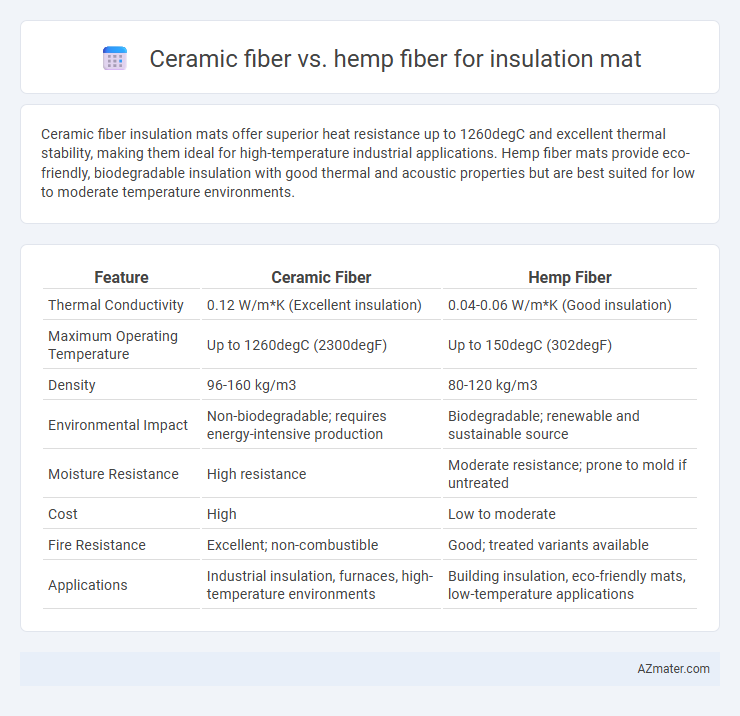Ceramic fiber insulation mats offer superior heat resistance up to 1260degC and excellent thermal stability, making them ideal for high-temperature industrial applications. Hemp fiber mats provide eco-friendly, biodegradable insulation with good thermal and acoustic properties but are best suited for low to moderate temperature environments.
Table of Comparison
| Feature | Ceramic Fiber | Hemp Fiber |
|---|---|---|
| Thermal Conductivity | 0.12 W/m*K (Excellent insulation) | 0.04-0.06 W/m*K (Good insulation) |
| Maximum Operating Temperature | Up to 1260degC (2300degF) | Up to 150degC (302degF) |
| Density | 96-160 kg/m3 | 80-120 kg/m3 |
| Environmental Impact | Non-biodegradable; requires energy-intensive production | Biodegradable; renewable and sustainable source |
| Moisture Resistance | High resistance | Moderate resistance; prone to mold if untreated |
| Cost | High | Low to moderate |
| Fire Resistance | Excellent; non-combustible | Good; treated variants available |
| Applications | Industrial insulation, furnaces, high-temperature environments | Building insulation, eco-friendly mats, low-temperature applications |
Overview of Ceramic Fiber and Hemp Fiber
Ceramic fiber insulation mats provide excellent thermal resistance, high-temperature stability up to 2300degF (1260degC), and superior chemical inertness, making them ideal for industrial applications requiring fire and heat protection. Hemp fiber insulation mats offer eco-friendly, biodegradable properties with good thermal and acoustic insulation, boasting a lower environmental footprint and natural moisture regulation. Both materials differ significantly in temperature tolerance and sustainability, with ceramic fibers excelling in extreme heat environments while hemp fiber supports green building initiatives.
Composition and Material Properties
Ceramic fiber insulation mats consist primarily of alumina and silica oxides, providing high-temperature resistance up to 1260degC and excellent thermal stability, making them ideal for industrial applications. Hemp fiber mats are composed of natural cellulose and lignin, offering moderate thermal insulation with benefits of biodegradability, moisture regulation, and sound absorption under temperatures typically below 100degC. The inorganic nature of ceramic fibers ensures superior fire resistance and durability, while hemp fibers provide eco-friendly, renewable insulation with lower environmental impact but reduced thermal performance compared to ceramic fibers.
Thermal Insulation Performance
Ceramic fiber insulation mats offer superior thermal resistance withstanding temperatures up to 1260degC (2300degF), making them ideal for high-temperature industrial applications. Hemp fiber mats provide moderate thermal insulation with lower thermal conductivity, suitable for sustainable, eco-friendly building projects operating under standard temperature ranges. Comparing thermal performance, ceramic fiber mats deliver enhanced heat retention and durability in extreme environments, whereas hemp fiber mats prioritize natural breathability and environmental benefits over maximum heat resistance.
Fire Resistance and Safety
Ceramic fiber insulation mats offer exceptional fire resistance withstanding temperatures above 2300degF (1260degC), providing superior safety in high-heat environments compared to hemp fiber mats, which typically resist up to 200degC. Hemp fiber insulation, while biodegradable and eco-friendly, is inherently more combustible and requires chemical treatments to enhance fire retardancy, potentially compromising safety and environmental benefits. The non-combustible nature and thermal stability of ceramic fibers make them the preferred choice for critical applications demanding maximum fire protection and long-term safety.
Environmental Impact and Sustainability
Ceramic fiber insulation mats offer high thermal resistance but are energy-intensive to produce and non-biodegradable, leading to long-term environmental concerns. Hemp fiber mats provide excellent insulation with low embodied energy, biodegradability, and carbon sequestration benefits, making them a more sustainable choice. Hemp's renewable nature and minimal ecological footprint position it as an eco-friendly alternative in sustainable building materials.
Durability and Longevity
Ceramic fiber insulation mats exhibit superior durability and longevity due to their high resistance to heat, chemical degradation, and physical wear, making them ideal for industrial and high-temperature applications. Hemp fiber mats offer eco-friendly insulation with moderate durability, but they are more susceptible to moisture damage, biological degradation, and compression over time. For long-term performance in harsh environments, ceramic fiber insulation provides enhanced structural integrity and thermal stability compared to hemp fiber alternatives.
Cost Comparison
Ceramic fiber insulation mats typically have a higher initial cost compared to hemp fiber mats due to their superior heat resistance and durability. Hemp fiber mats are more affordable and offer a natural, sustainable alternative with moderate insulating properties but may require more frequent replacement. The choice between the two often hinges on budget constraints and specific thermal performance requirements.
Installation and Handling
Ceramic fiber insulation mats are lightweight and easy to cut with standard tools, allowing for precise fitting in high-temperature applications; however, they require careful handling with protective gear due to irritant dust. Hemp fiber mats offer excellent flexibility and natural resistance to mold and pests, making installation straightforward and safe without the need for special protective equipment. Both materials provide efficient insulation, but hemp fiber stands out for ease of handling, while ceramic fiber excels under extreme heat conditions.
Health and Safety Considerations
Ceramic fiber insulation mats offer high heat resistance but pose respiratory risks due to airborne fiber particles, necessitating the use of protective gear during installation. Hemp fiber insulation mats provide a natural, non-toxic alternative with excellent breathability and moisture regulation, reducing potential health hazards. Choosing hemp fiber minimizes exposure to irritants commonly associated with synthetic fibers, promoting safer indoor air quality.
Best Applications for Each Fiber Type
Ceramic fiber insulation mats excel in high-temperature applications such as furnaces, kilns, and industrial ovens due to their exceptional thermal stability and resistance to thermal shock. Hemp fiber insulation mats are best suited for eco-friendly building projects and residential insulation, offering natural moisture regulation, sound absorption, and sustainability benefits. Each fiber's thermal performance and environmental impact determine its optimal use, with ceramic fibers favored in extreme heat environments and hemp fibers preferred for sustainable, low-temperature insulation needs.

Infographic: Ceramic fiber vs Hemp fiber for Insulation mat
 azmater.com
azmater.com